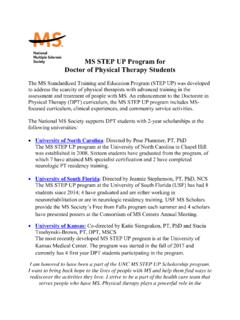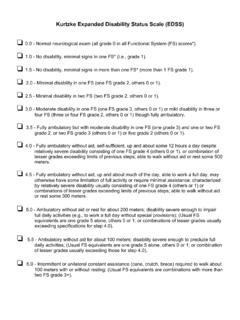Transcription of A RESOURCE FOR HEALTHCARE PROFESSIONALS Physical …
1 A RESOURCE FOR HEALTHCARE PROFESSIONALS Physical Therapy in Multiple Sclerosis Mandy Rohrig, PT, DPT, MSCS National MS Society | Physical Therapy in MS 1 The National MS Society s professional RESOURCE Center provides: Easy access to comprehensive information about MS management in a variety of formats; Dynamic, engaging tools and resources for clinicians and their patients; Clinical information to support high quality care; and Literature search services to support high quality clinical care. FOR FURTHER INFORMATION: VISIT OUR WEBSITE: To receive periodic research and clinical updates and/or e-news for HEALTHCARE PROFESSIONALS , EMAIL: 2018 National Multiple Sclerosis Society. All rights reserved. National MS Society | Physical Therapy in MS 2 Table of Contents INTRODUCTION.
2 3 MS OVERVIEW .. 3 THE ROLE OF Physical THERAPY IN MS COMPREHENSIVE CARE ..4 EVOLUTION OF THE ROLE OF EXERCISE AND Physical ACTIVITY IN PEOPLE WITH MS ..7 CURRENT EVIDENCE .. 8 PROGNOSIS, GOAL SETTING, AND PLAN OF CARE ..13 SUMMARY ..14 National MS Society | Physical Therapy in MS 3 Introduction Rehabilitation is an essential component of comprehensive care for persons with multiple sclerosis (MS). MS is an unpredictable, fluctuating disease that progresses over time. Therefore, the rehabilitation team must be knowledgeable about the range of symptoms that can occur and be responsive to their variability from one person to another. Unlike most other neurological disorders, including spinal cord injury, traumatic brain injury, and stroke, there is no fixed deficit in MS; symptom profile, disease activity and MRI burden are all variable.
3 Therapists must be prepared to treat each MS patient individually, with flexibility, throughout the disease course. The majority of people with MS are diagnosed between the ages of 20 and 50, at the peak of their career and childrearing years; however, MS can also occur in children, teens and older adults. Although there is a slight reduction in life expectancy for people with MS, rehab PROFESSIONALS will often attend to the needs of an older population with MS. In the treatment of people with MS, there are no protocols or time limits just a unique opportunity to employ numerous problem-solving skills, interventions, and resources. And because MS affects not just an individual, but a whole family, it is a disease that benefits from a team approach making coordination and communication with other health care providers extremely important.
4 MS Overview MS is a chronic, immune-mediated disease of the central nervous system (brain, spinal cord and optic tracts) that is characterized in the majority of people by relapses (also known as exacerbations) and remissions of neurological symptoms, and variable progression of disability over time. In addition to relapsing forms of MS, a small subset of people have a disease course that is progressive from onset with few or no clinical relapses over time (known as primary progressive MS). In MS, the body s immune system directs repeated inflammatory attacks on the central nervous system, which cause damage to the myelin covering on nerve fibers, the nerve fibers themselves and the cells (oligodendrocytes) that make myelin. Symptoms of MS are highly variable, but commonly include fatigue, mood and cognitive changes, vision problems, sensory loss, pain, coordination problems, impaired ambulation, and elimination dysfunction.
5 The cause of MS is not known, but current research points to an interaction of genetic, lifestyle and environmental factors. Treatments for MS, known as disease modifying therapies, may reduce the number of relapses, delay the accumulation of disability and limit the development of new areas of damage in the brain and spinal cord. National MS Society | Physical Therapy in MS 4 Exacerbation versus Pseudo-Exacerbation: Exacerbation (also referred to as a relapse, flare or attack): o New or worsening symptoms lasting at least 24 hours o Usually associated with inflammation and demyelination in the central nervous system (CNS -- brain, spinal cord and optic nerves) o Separated from the last exacerbation by at least 30 days Pseudo Exacerbation: o Temporary flare-up of symptom(s) lasting less than 24 hours o Symptoms not associated with CNS inflammation or damage o Possible triggers.
6 Increase in core body temperature due to infection, heat or humidity, exercise, bladder or bowel fullness and/or stress o Symptoms return to baseline when trigger is minimized/eliminated Resources For patients For clinicians MS Coalition Consensus Paper The Use of Disease-Modifying Therapies in Multiple Sclerosis: Principles and Current Evidence The Role of Physical Therapy on The MS Team A multidisciplinary team provides comprehensive care for the person living with MS as well as the family and caregivers. People living with MS can create their team by using the Partner in MS Care RESOURCE and/or by calling an MS Navigator at 800-344-4867 to ask for referrals. The Role of Physical Therapy Role in MS Comprehensive Care Physical therapists play an integral role in the management of MS throughout the disease course at diagnosis, during and after relapses, during periods of progression as well as periods of stability, and when the disease becomes more advanced.
7 Key elements and priorities of a Physical therapy interaction for different disease phases are highlighted below. At the Time of Diagnosis Education- Explaining the role of PT in helping people stay active, mobile, safe and comfortable National MS Society | Physical Therapy in MS 5o Offering educational resources for the person with MS and her or his family members Thorough Physical therapy examination and evaluation to establish baselines o Identifying areas of Physical abilities and areas for improvement o Setting realistic goals and expectation while providing emotional support o Initiating care may involve evaluation and a few follow-up visits. Follow-up visits are infrequent ( 1 session/week or 1 session/month for total of 3-5 visits) for exercise monitoring, assurance of adherence, and exercise progression.
8 Exercise and Physical activity program o Establishing an evidence-based exercise and Physical activity program for the person with MS based on the patient s Physical therapy evaluation, interests, and access. o Emphasizing the importance of regular exercise for successful disease management and optimizing health. During Periods of Stability Physical therapists should monitor the mobility of people with MS even during periods of no clinical or radiographical disease changes/progression. The patient may consult with Physical therapy every 3-6 months to assure adherence to exercise and Physical activity recommendations, as well as to make appropriate modifications to the program. Similar to medical check-ups, the patient can participate in rehabilitation tune-ups.
9 A Physical therapy session may include assessment of strength, balance, flexibility, and cardiorespiratory abilities. These objective measures may be used as a comparison in the future. The Physical therapist helps to maintain patient motivation during such a time, as the person may be less consistent with exercise when all is good. During and After a Relapse The primary goal for Physical therapy during and after a relapse is to regain the previous level of function. The timing of Physical therapy during and/or after a relapse can vary depending on the severity of the attack, influence of corticosteroids (the usual treatment for a severe relapse), and the level of function prior to the relapse. The initial examination/evaluation may be abbreviated as fatigue will likely impact participation.
10 Safe mobility, optimal functioning, and personalized exercise plans geared to the person s changing needs are key treatment goals. Implementing the use of adaptive equipment and assistive devices, both temporary and permanent, may be necessary. Patients and families are understandably fearful of the impact the relapse may have on their lives in the home, at work, and in the community. The Physical therapist needs to be supportive and encouraging, while providing realistic hope and optimism. National MS Society | Physical Therapy in MS 6 With Disease Progression With disease progression, the patient may have an increasing need for adaptive equipment ( grab bars, shower chairs, etc.) and mobility equipment ( walkers, scooters, or wheelchairs).











